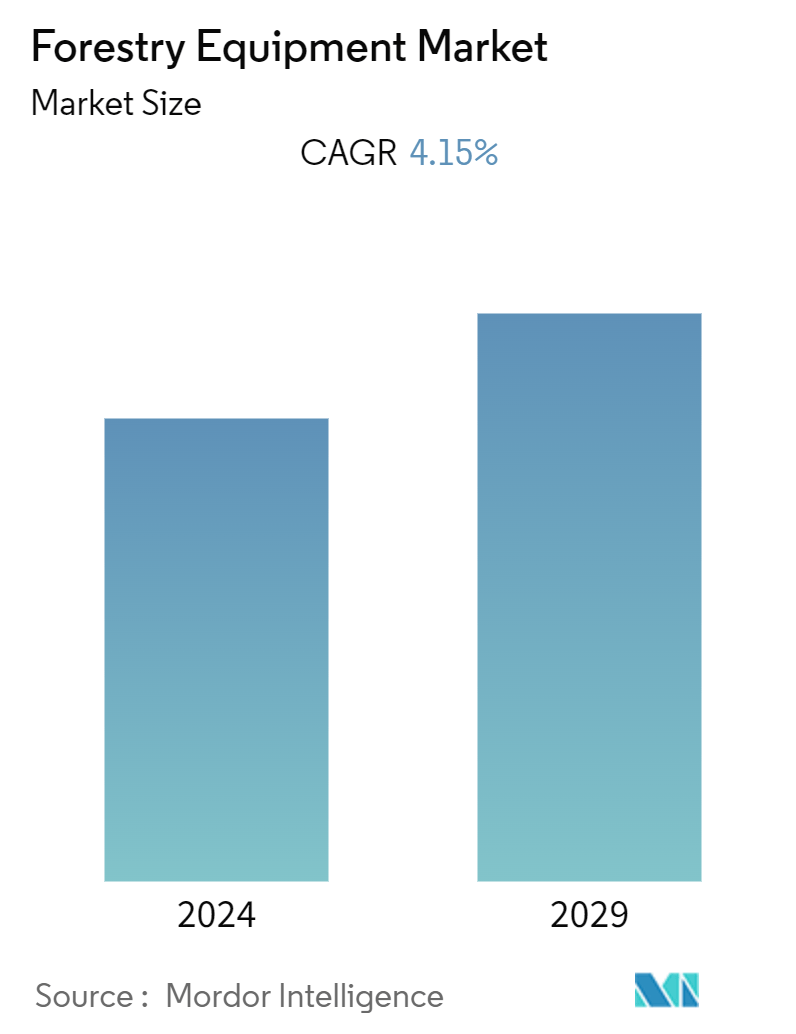Market Size of Forestry Equipment Industry

| Study Period | 2019 - 2029 |
| Base Year For Estimation | 2023 |
| CAGR (2024 - 2029) | 4.15 % |
| Fastest Growing Market | Asia Pacific |
| Largest Market | North America |
| Market Concentration | Low |
Major Players
*Disclaimer: Major Players sorted in no particular order |
Forestry Equipment Market Analysis
The Forestry Equipment Market is expected to register a CAGR of 4.15% during the forecast period.
The market is growing owing to the rising awareness about forest preservation and management in several developed and developing countries and the transition in forestry operations from manual work to mechanized and automated modes of operation in forests.
- With the present scope in the forest industry, the role of forest management has been growing rampantly with the aim of planning and implementing practices for the stewardship and use of forests to meet specific environmental, economic, social, and cultural objectives. While the objectives of management vary widely and include the protection of resources in protected forests and nature reserves, the primary objective has often been the production of wood products. A basic tenet of forest management has been a significant focus on wood production, which is 'sustained yield,' or harvesting the wood increment without drawing down on the forest capital.
- This has been largely supported by significant government investment as healthy forests depend on a healthy forest products industry. For instance, in April 2023, the US government announced USD 33.7 million from President Biden's Bipartisan Infrastructure Law for projecting funds to strengthen the wood products economy and promote sustainable forest management. This investment supports a crucial link between resilient, healthy forests and strong rural economies and jobs in the forestry sector, especially in communities that depend on national forests and grasslands to grow and thrive.
- In addition to this, the role of forestry is gaining prominence in Latin America to bring back the historic flourishing Atlantic Forest that once covered a vast swath of Brazil, Paraguay, and Argentina. But five centuries of logging, agricultural expansion, and the relentless growth of cities like Sao Paulo and Rio de Janeiro reduced it to fragments. Thus, various organizations have been working for more than three decades to preserve and restore what remains.
- As per the UN, approximately 700,000 ha of land have already been restored, and the goal is to protect and revive 1 million ha by 2030 and 15 million ha by 2050, an area bigger than all of Nepal, Greece, or Nicaragua. Thus, the increase in forestry maintenance activities in Latin America is expected to propel the demand for large forestry machines.
- However, the high cost and lack of awareness associated with forestry equipment is expected to slow down the growth of the market. Due to the lack of information about the equipment, the adoption is still not widespread in developing countries.
Forestry Equipment Industry Segmentation
Forestry equipment is specially designed machinery that performs various tasks such as extracting, logging, and felling. Forestry equipment also helps increase the work's efficiency and reduce labor costs.
The market size is evaluated by analyzing various types of forestry equipment segmented by product types, such as felling equipment (chainsaws, harvesters, and feller bunchers), extracting equipment (forwarders and skidders), on-site processing equipment (chippers and grinders, delimbers and slashers, and other on-site processing equipment), separately sold parts and attachments (saw chain, guide bars, discs, and teeth, harvesting, and other cutting heads), and other forestry equipment (loaders, mulchers and other forestry equipment) across the globe. Further, the market study focuses on the impact of COVID-19 and macroeconomic factors on the market ecosystem. The study also tracks the key market parameters, underlying growth influencers, the impact of macroeconomic trends on the market, and major vendors operating in the industry, which support the market estimations and growth rates over the forecast period. The market sizes and forecasts are provided in terms of value in USD for all the above segments.
| By Product Type | |||||
| |||||
| |||||
| |||||
| |||||
|
| By Geography | |
| North America | |
| Europe | |
| Asia | |
| Australia and New Zealand | |
| Latin America | |
| Middle East and Africa |
Forestry Equipment Market Size Summary
The forestry equipment market is experiencing growth driven by increased awareness of forest preservation and the shift towards mechanized and automated forestry operations. This transition is supported by significant government investments aimed at promoting sustainable forest management and strengthening the wood products economy. The market is also witnessing a rise in forestry maintenance activities, particularly in Latin America, where efforts are underway to restore the historic Atlantic Forest. This restoration is expected to boost the demand for large forestry machines. However, challenges such as high costs and limited awareness of forestry equipment in developing countries may hinder market growth.
The on-site processing equipment segment is projected to see substantial growth, fueled by the rising production of wood pellets for power plants. Chippers, essential for producing uniform wood chips, are in demand due to rapid urbanization and the need for large-scale tree-clearing services. North America is expected to experience significant growth, driven by increased aftermarket sales and the adoption of modified logging techniques. The region's focus on mass timber and bioenergy generation is further propelling the demand for various forestry equipment. The market is highly fragmented, with major players like Deere and Company, Komatsu Ltd., and Volvo CE actively enhancing their product offerings through strategic partnerships and acquisitions.
Forestry Equipment Market Size - Table of Contents
-
1. MARKET INSIGHTS
-
1.1 Market Overview
-
1.2 Industry Attractiveness - Porter's Five Forces Analysis
-
1.2.1 Bargaining Power of Suppliers
-
1.2.2 Bargaining Power of Buyers
-
1.2.3 Threat of New Entrants
-
1.2.4 Threat of Substitutes
-
1.2.5 Degree of Competition
-
-
1.3 Industry Value Chain Analysis
-
1.4 Impact of COVID-19 and Macro Economic Trends on the Industry
-
-
2. MARKET SEGMENTATION
-
2.1 By Product Type
-
2.1.1 Felling Equipment
-
2.1.1.1 Chainsaws
-
2.1.1.2 Harvesters
-
2.1.1.3 Feller Bunchers
-
-
2.1.2 Extracting Equipment
-
2.1.2.1 Forwarders
-
2.1.2.2 Skidders
-
2.1.2.3 Other Extracting Equipment
-
-
2.1.3 On-Site Processing Equipment
-
2.1.3.1 Chippers and Grinders
-
2.1.3.2 Delimbers and Slashers
-
2.1.3.3 Other On-Site Processing Equipment
-
-
2.1.4 Other Forestry Equipment
-
2.1.4.1 Loaders
-
2.1.4.2 Mulchers
-
2.1.4.3 Other Forestry Equipment
-
-
2.1.5 Separately Sold Parts and Attachments
-
2.1.5.1 Saw Chain, Guide Bars, Discs, and Teeth
-
2.1.5.2 Harvesting and Other Cutting Heads
-
2.1.5.3 Other Parts and Attachments
-
-
-
2.2 By Geography
-
2.2.1 North America
-
2.2.2 Europe
-
2.2.3 Asia
-
2.2.4 Australia and New Zealand
-
2.2.5 Latin America
-
2.2.6 Middle East and Africa
-
-
Forestry Equipment Market Size FAQs
What is the current Forestry Equipment Market size?
The Forestry Equipment Market is projected to register a CAGR of 4.15% during the forecast period (2024-2029)
Who are the key players in Forestry Equipment Market?
Deere and Company, Komatsu Ltd, Volvo CE, Hitachi Construction Machinery Co. Ltd and Barko Hydraulics LLC are the major companies operating in the Forestry Equipment Market.

